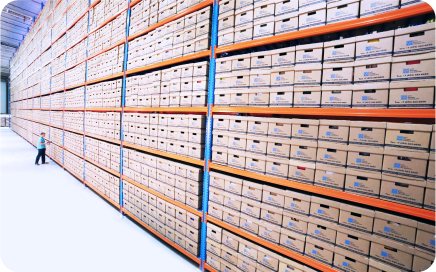How to Choose the Right Warehouse Management System for a Growing Wholesaler
By Rackbeat August 22, 2025

As a wholesaler grows, so do the challenges in the warehouse: more products, more customers, more orders, more suppliers – and often also more errors, wasted time, and inefficiencies. It’s only natural to start considering a Warehouse Management System (WMS). But is it always the right time?
Not necessarily.
In this article, you’ll find a practical guide on how to make the right decision – whether you’re in the early stages or already well on your way to professional warehouse management. You’ll learn:
How to identify your real needs before investing in an inventory management solution.
When it makes sense to stick with Excel or your current accounting/ERP system.
When a dedicated WMS can make a significant difference.
What alternatives and middle-ground solutions exist, such as purchasing management, hardware, or integrations.
When it might be best to wait – and what you should have in place first.
Which criteria to use when evaluating the right system, once the time is right.’
1. Understand Your Needs: What Problem Are You Trying to Solve?
When a business grows, it’s tempting to jump straight to the conclusion: “We need a WMS.” But a warehouse management system is only valuable if it solves the right problems. That’s why the first step should always be to map out where the biggest friction points really lie.
Some of the most common challenges include:
Too many order fulfillment errors. Customers receive the wrong products, shipments are incomplete, or orders don’t leave on time. Mistakes like these cost money, time, and customer trust. A system can help – but only once you know exactly where the errors occur.
Time-consuming manual entries. If employees spend hours each week entering data into spreadsheets or accounting systems, inefficiency and mistakes are inevitable. But ask yourself: is this because you’re missing a system – or because your current tools aren’t being used effectively?
Lack of visibility into stock levels and inventory value. Not knowing what’s on hand or what it’s worth often leads to overstocking or stockouts – tying up cash and hurting customer service. This is a typical sign that the need for more structured warehouse management is emerging.
Chaotic workflows. When multiple employees work in the warehouse without clear routines, they can easily disrupt each other. Perhaps two people are picking from the same shelf at once, or products are stored in different places depending on who handled them. Often, refining processes and roles is more effective before investing in a new system.
Defining your main challenges is crucial. You might discover that the problem can be solved through better processes, staff training, or small adjustments to your current setup. Only when your needs are clearly defined can you decide whether a WMS is the right investment – or if optimizations are enough for now.
2. When Does Excel or ERP Alone Make Sense?
For many small wholesalers, spreadsheets or the built-in features of an accounting/ERP system are both practical and cost-effective in the early growth stages. A full WMS isn’t always necessary right away, and you can get far with the tools you already have.
It makes sense to stick with Excel or ERP alone if:
You manage a relatively small product catalog (e.g., under 500 SKUs).
The warehouse is handled by one or two people who have complete visibility.
Growth hasn’t yet reached the point where specialized warehouse management is required.
In this phase, the focus should be on making the most of your current setup:
Perform regular inventory counts to avoid surprises.
Implement clear shelf labeling and zoning.
Assign responsibilities to avoid overlap.
Create simple picking lists or checklists to reduce order errors.
For some businesses, this approach can work for years – until complexity naturally outgrows what spreadsheets and ERP can handle.
3. When Is It Time for a Warehouse Management System (WMS)?
A dedicated WMS really starts to add value once business complexity outpaces what spreadsheets or ERP alone can manage. That’s the point where manual methods start costing more than they save.
Clear signs that you’ve reached this stage include:
Managing thousands of SKUs or multiple product variations.
Multiple employees working in the warehouse simultaneously, creating bottlenecks.
Errors in orders or counts that are becoming costly.
Increasing requirements for batch or serial number tracking.
The need to scale without hiring significantly more staff.
At this stage, a WMS brings structure, reduces errors, and frees up resources so employees can focus on value-adding tasks such as order management, purchasing, and customer service.
4. Alternative Solutions: Integrations, Purchasing Management, and Hardware
A full Warehouse Management System (WMS) is not always the only answer to your challenges. Many wholesalers can, during a transition phase, cover their needs by adding modules, integrations, or hardware for warehouse management. These solutions can give you a significant boost in efficiency – without requiring you to invest in a complete system right away.
Purchasing Management in ERP
One of the most common challenges in a growing wholesale business is ordering the right products in the right quantities. With a solid purchasing module in your existing ERP, you can:
Receive suggestions for reorders based on sales data and minimum stock levels.
Avoid empty shelves, which lead to dissatisfied customers.
Minimize tied-up capital in products you don’t need right now.
Often, purchasing management in your ERP system can be enough to improve warehouse management flow, especially if the problem is more about incoming stock than the picking and packing processes.
Hardware for Warehouse Management
You don’t need a full WMS to make warehouse work more efficient. Small investments in warehouse management hardware – typically handheld scanners or mobile devices – can be a gamechanger when:
Employees spend too much time locating or counting items manually.
You want to reduce typing errors during registrations.
The warehouse is growing, but you don’t want to hire more staff to perform the same tasks.
Handheld scanners can integrate directly with your ERP or webshop, making it possible to pick, pack, and register in real time. This provides many of the benefits of a WMS – just in a simpler version.
E-commerce Integrations
For wholesalers with a webshop or B2B portal, order processing is often a major time sink. If you have to enter order data manually into several systems, the risk of errors and double work increases. With an integration between your webshop and ERP, you can:
Transfer orders automatically to the warehouse.
Keep stock levels synchronized in real time.
Minimize administrative tasks, allowing the focus to remain on customer service and sales.
In this way, you can strengthen order management and create a more streamlined workflow without having to restructure your entire warehouse setup.
When Does It Make Sense to Choose a Middle Ground?
These alternative solutions are particularly relevant if you are experiencing early challenges but are not ready for the full investment in a WMS. Maybe your growth is still uncertain, or maybe your needs are limited to specific parts of warehouse management. In those cases, modules, integrations, and hardware can be a smart way to test and prepare the company for a later transition to a complete system.
In short: By combining purchasing management, integrations, and warehouse management hardware, you can achieve many of the benefits of a WMS – but on a smaller scale and with a lower investment.
5. Should You Wait?
Sometimes, the right decision is to hold off on investing in a WMS, especially if:
Your growth is still unstable and your future needs are unclear.
Internal processes aren’t yet standardized – a messy warehouse won’t magically improve with software.
Your resources would be better invested elsewhere in the short term.
Timing is crucial. Implementing a WMS requires training, process adjustments, and ongoing maintenance.
6. Criteria When Choosing a System
Once the decision to invest in a WMS has been made, it is essential to select the right system – and that requires clear criteria. A system is not just a technical solution, but a tool that should fit both your business goals, your employees, and your future plans.
Here are the most important criteria you should consider:
Scalability. Choose a system that can grow with your business. Maybe you have 2,000 products today – but what if you have 10,000 in three years? Or several warehouse locations? A system must be able to follow your development, so you don’t have to replace it too soon.
Ease of use. A system can have all the functions in the world, but if it’s difficult to use, it will stand in the way of efficiency. Ask yourself: can a new employee learn it in just a few days? Is the interface intuitive, or does it require special knowledge? The easier a system is to use, the faster you will see a return on your investment.
Integrations. A good WMS cannot stand alone. It must integrate with your accounting system, ERP, webshop, transport solutions, scanners, and other tools. Integrations save time, reduce the risk of errors, and ensure data flows freely between systems. Make sure to check which integrations the vendor already offers and how flexible the system is for future needs.
Support and industry knowledge. Technology is only as strong as the support behind it. Choose a vendor that offers reliable support and understands the wholesale industry. The best vendors act as partners who can advise you on both technology and processes.
Price and pricing model. A WMS is an investment, so price transparency is key. Check whether the price covers setup, licenses, integrations, and ongoing updates. Some systems seem inexpensive at first but become costly as you grow. Ensure the pricing model matches both your budget and your long-term ambitions.
A practical exercise is to create two lists:
A must-have list with features you cannot live without.
A nice-to-have list with features that would be a bonus, but are not essential.
This way, you can compare systems objectively and avoid being dazzled by flashy features that don’t actually solve your real needs.
7. Summary: Choose Based on Your Position
Choosing a WMS is not only about software. It’s about knowing your company’s current situation and being realistic about your needs, resources, and ambitions. A system is only a good investment if it fits your situation – otherwise, you risk paying for something you can’t fully utilize.
Do you still have a manageable warehouse? Then you can benefit from optimizing internal procedures and continuing with the tools you already use. Small improvements in processes and routines can often create great value without requiring new systems.
Are you experiencing growing complexity? Then integrations, purchasing management modules, and simple warehouse hardware can be a good “middle ground” to help you solve concrete challenges without immediately taking the leap into a full WMS.
Are you in a situation of strong growth and frequent errors? Then it’s probably time to invest in a dedicated WMS. It will create structure, reduce errors, and give you the overview you need when the warehouse becomes a strategic cornerstone of your business.
In short: Choose the solution that matches your current reality – but always keep an eye on how your warehouse and your company are expected to develop in the future.
Final Note: Stay Ahead with Expert Insights
Whether you’re considering a WMS now or simply preparing for future growth, staying informed is key. By subscribing to our newsletter, you’ll get expert insights, practical tips, and the latest updates on warehouse management straight to your inbox. It’s an easy way to make sure you’re always one step ahead in optimizing your wholesale operations.


